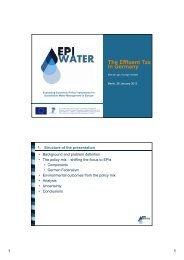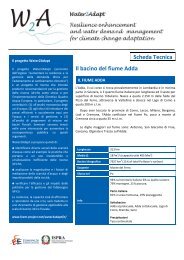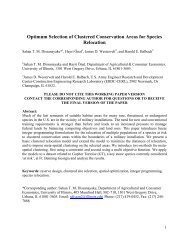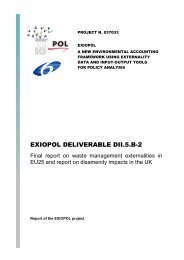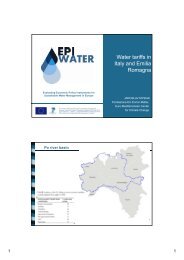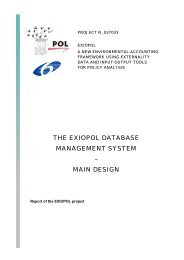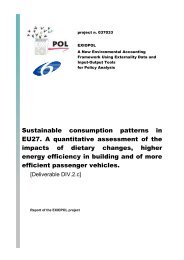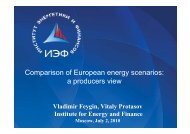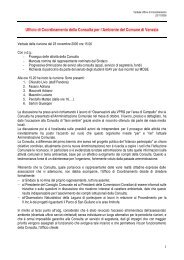Gulf and European Energy Supply Security - Feem-project.net
Gulf and European Energy Supply Security - Feem-project.net
Gulf and European Energy Supply Security - Feem-project.net
Create successful ePaper yourself
Turn your PDF publications into a flip-book with our unique Google optimized e-Paper software.
of unconventional gas, has already had significant<br />
impact on the EU gas market via world LNG trade<br />
flows <strong>and</strong> spot market prices for gas.<br />
The increase in US indigenous production has<br />
led to a change in worldwide LNG trade flows in<br />
the few last years. <strong>European</strong> gas spot market prices<br />
have decoupled from oil <strong>and</strong> pipeline gas prices.<br />
Lower spot market prices in the EU led to a<br />
temporary change of Russian long-term contracts:<br />
a 15 percent gas-to-gas price component in the<br />
long-term contracts was introduced <strong>and</strong> will be<br />
valid for three years. The decoupling of gas prices<br />
is due to the economic <strong>and</strong> financial crisis <strong>and</strong> the<br />
decline in gas dem<strong>and</strong>, not just to changes in LNG<br />
flows.<br />
With the decline in LNG dem<strong>and</strong> in the US, more<br />
LNG has found its way to the EU. The decrease in US<br />
dem<strong>and</strong>, in combination with the fact that additional<br />
liquefaction capacity has come online from Qatar<br />
<strong>and</strong> elsewhere in the same period, has encouraged<br />
EU gas importers to increase LNG purchases. This<br />
results in increased diversification of EU imports <strong>and</strong><br />
increases flexibility, facilitating the replenishment<br />
of gas storage after the very cold winter of 2009.<br />
LNG imports into the EU increased by 26 percent,<br />
from around 50 bcm in 2008 to 63 bcm in 2009. This<br />
happened despite an overall decrease of 6 percent<br />
in EU natural gas dem<strong>and</strong>.<br />
In short, unconventional gas has increased<br />
world gas reserves <strong>and</strong> production, <strong>and</strong> LNG has<br />
allowed regional developments to impact the<br />
world gas market. Regardless of whether the EU<br />
will be able to replicate the production revolution<br />
witnessed in the US, the increasing supply of<br />
unconventional gas has already had significant<br />
influence on the world gas market <strong>and</strong> thus on<br />
the EU, where it has put a downward pressure on<br />
gas prices. However, if unconventional gas turns<br />
into a waiting game for global gas investments,<br />
then this could lead to a serious security of supply<br />
threat because of the long lead-times for gas<br />
infrastructure <strong>project</strong>s.<br />
5.1 Unconventional Gas Reserves in Europe 26<br />
Currently, Europe has an estimated 5.4 tcm<br />
(trillion cubic meters) of proven reserves enough to<br />
Geopolitical Issues of Europe’s Future Gas <strong>Supply</strong><br />
meet approximately 10 years of EU consumption.<br />
When it comes to unconventional gas resources,<br />
these reserves become significantly higher as total<br />
resources are estimated at approximately 35 tcm for<br />
Europe. Gas recovery rates vary from around 8 to 30<br />
percent, but this could increase to approximately<br />
40 percent with a production cost of around $100<br />
to $300 per 1000 m3 in the long run, according to<br />
IEA estimates. At recovery rates of 40 percent, this<br />
would mean an increase in <strong>European</strong> gas reserves<br />
from 5.4 TCM to 19.4 tcm.<br />
Assuming an annual indigenous <strong>European</strong><br />
production (EU <strong>and</strong> Norway) of 300bcm per<br />
year, we can assume that indigenous <strong>European</strong><br />
production, at 300bcm per year, could be<br />
extended from 18 years to 65 years. Assuming a<br />
less optimistic recovery rate of 25 percent would<br />
increase <strong>European</strong> reserves by 8.75bcm, increasing<br />
the current R/P ratio from 18 years to 47 years. This<br />
would have a considerable effect on security of<br />
supply in the EU, but whether the US experience<br />
can be replicated in the EU is subject to a number<br />
of uncertainties.<br />
Very little is known about potential costs,<br />
environmental impact <strong>and</strong> the legislative framework<br />
of unconventional gas production. Environmental<br />
<strong>and</strong> legal issues may significantly hinder the<br />
production of shale gas in Europe. Europe has a<br />
more stringent legislation, a different geography<br />
<strong>and</strong> a much higher population density.<br />
Unconventional gas production, know-how<br />
<strong>and</strong> technology have so far been limited to the<br />
US. Although major consolidation has taken place<br />
in recent years, whereby international oil <strong>and</strong> gas<br />
companies have acquired unconventional gas firms,<br />
the transfer of this know-how to the EU <strong>and</strong> the rest<br />
of Europe has not yet begun. Critical technology<br />
know-how includes horizontal drilling <strong>and</strong> hydraulic<br />
fracturing, which are key techniques to be mastered<br />
in order to make unconventional gas economically<br />
viable <strong>and</strong> to ensure that underground aquifers are<br />
not contaminated.<br />
Finally, the connection of unconventional gas<br />
production to the EU gas grid is also an issue of<br />
uncertainty.




